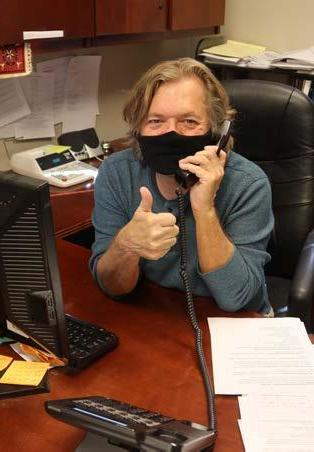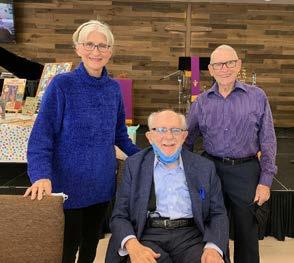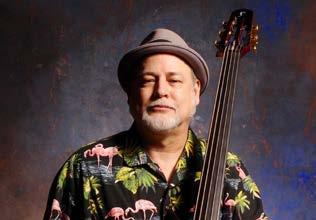
15 minute read
Nashville Cat Wayne Moss

Brian Blauser photo, courtesy of the West Virginia Music Hall of Fame
A Cinderella Story ... about a true believer and his guitar
by Warren Denney
Wayne Moss holds a singular, heavy place in Nashville music history — and, standing to reason — in American popular music history. He was there when the deal went down.
Of course, playing guitar on Roy Orbison’s “Oh, Pretty Woman,” Waylon Jennings’ “Only Daddy That’ll Walk the Line,” and on Dylan’s Blonde on Blonde will place you deeply within the story. And, that’s just scratching the surface.
A guitarist of extraordinary talent, gifted with hands seemingly made for the skill, and a player who found himself assuredly in the right place at the right time, his iconic riffs helped to establish the fingerprint of so many country and rock & roll hits during the 1960s and 1970s.
Born in Charleston, West Virginia, Moss’s life could have easily taken a different course. An oft-told story carries career-making freight.
“My mother [Mattie Moss] was a stage mom,” he said recently, from his home in Madison. “And she wrote letters to Lawrence Welk, and to Randy Wood, and Chet Atkins, and said, ‘You’ve got to hear my kid.’ Nobody showed any interest except Chet [Atkins] and he told her to bring me down here, and he’d listen to me play. So, I came here to Nashville at age 15, and played a bunch of Chet songs for Chet. My mother says, ‘Isn’t he amazing?’ Chet says, ‘No, he’s average.’
“She says, ‘Well, what do you suggest he do?,’ and Chet said ‘Well, if I had it to do over again, I’d get in another line of work because there's too many headaches and heartaches in this business, but I don't know. He looks like he’d make a good plumber. I don’t know. I got to go.’”
The scene was burned into the boy’s memory, and most certainly Atkins knew exactly what he was doing. Moss, now 83, became resolute.
“So, that could either crush you or make you determined,” he said. “It made me determined. I went back to West Virginia to listen to a bunch of Les Paul, and Johnny Smith, and Chuck Berry — a bunch of things. I worked on a TV show in my teenage years on WOAY-TV in Oak Hill, West Virginia and Charlie McCoy was right down the street in Fayetteville, West Virginia. He used to watch me on TV, and Russ Hicks was in Beckley, and he watched me, too. We didn’t really hook up in West Virginia, but we did after we got here.”
Those years made Moss. He learned who he was and began to understand who he could be. Often his influences came over the airwaves. He would listen to WLAC out of Nashville at night, to shows hosted by the legendary trio of Hoss Allen, Gene Nobles, and John Richbourg — the great John R.
“I listened to all that,” Moss said. “I got really heavy into R&B. It was that, more than anything else.”

Photo courtesy of the West Virginia Music Hall of Fame
Also, he went to work on the Wheeling Jamboree, beamed out on WWVA — the second-oldest country music broadcast in the U.S., behind the Grand Ole Opry. It was raw stuff — the real thing. You might hear Hawkshaw Hawkins, Wilma Lee and Stoney Cooper, Johnny Cash, or Doc Williams and the Border Riders.
Moss went to work on the Jamboree, and on the road, with rockabilly Bill Browning and the Echo Valley Boys.
He interviewed with Buzz Cason for the Casuals, the band considered to be Nashville’s first rock & roll outfit of note. The Casuals would become Brenda Lee’s backing band and record for Dot Records. Again, Moss’s mother played a key role.
“My mother and dad had divorced,” Moss said. “She was already here, working at H. Brown Furniture Company, which is down on Broad. The piano player with the Casuals — Richard Williams — came in there asking if anyone knew a guitar player looking for a job. My mother said, ‘Funny you should ask.’ So, I had been figuring out ways to do things up in West Virginia. For instance, I drilled a hole in the dashboard of my car, and I put a guitar jack in it, and hooked it up to the hot and ground lead on the volume control of the radio. That would allow me to play guitar in the car.
“That’s how I got the job with the Casuals. I played eight bars of Chuck Berry licks in my car, and Buzz Cason said, ‘You're hired.’”
In addition to his work with the Casuals, Moss would become a member of another rock & roll band, the Escorts, in 1961, one considered to be the best ever out of Nashville — and one that would play a foundational role in Moss’s life, leading to first-call studio work and countless historic sessions, and to his becoming a fundamental member of groundbreaking country-rock bands Area Code 615 and Barefoot Jerry. 1961 is also the year he opened his own Cinderella Sound, the popular studio that has hosted thousands of master recordings, and is still active today, run primarily by Moss’s wife, Dee Moeller.
The Escorts came into existence as the result of a falling out within another band, the Nightlifters, and the original lineup included Moss, the great Kenny Buttrey on drums, baritone saxophonist John Sturdivant, Jimmy Miller on tenor sax, Bill Aikins on keys, and the legendary Charlie McCoy on bass and harmonica. Another guitarist, legendary in his own right, Mac Gayden, would join the band in 1962.
“The thing with the Casuals lasted two and a half years,” Moss said. “And, between that and Charlie McCoy and The Escorts, I’ve been in every state in the Union except one. That’s Maine, and I’ve been in every providence in Canada except one. So, that’s a lot of roadwork and I don’t recommend that for anybody.
“In all those road gigs, I never did one tour in a bus. It was all in a Cadillac or something with an upright bass over my shoulder and inside a car — but you got to start somewhere.”
McCoy, of course would become a bandleader of greatest renown, in the studio, with the Escorts, and beyond. He would ultimately be elected to the Country Music Hall of Fame. Tales of those live gigs abound and resonate today. Stories of McCoy blowing a trumpet with one hand and playing bass with the other, along with tearing the roof off with his harp, Aikins doing the same by playing piano with his left hand and blowing another horn with his right, and the burning groove that lifted everyone are the stuff of myth. The Escorts eventually disbanded in 1968.

Photo courtesy of the Country Music Hall of Fame and Museum
Outside the rock & roll sphere, Moss was becoming an in-demand player through burgeoning friendships with Pig Robbins, Ray Edenton, and Harold Bradley, among others. Producer Billy Sherrill hired Moss, Edenton, and Jerry Kennedy as players on many of Tammy Wynette’s No. 1 hits.
“But, I had to start at the bottom and work my way up,” Moss said. “There was a song service, where people would send in a poem and musicians would put a melody to it and make a demo.
“We’d do that for a dollar a song and that’s where I met Pig Robbins — Ray Edenton, Harold Bradley, and some of the guys were instrumental in helping me get my foot in the door. Floyd Cramer was the first guy who ever took me fishing in Tennessee, and we became big buds. Grady Martin wasn’t as easy to get next to. He asked me one day at Columbia B ‘Who told you, you could sit in my chair?’ “So, I had to win him over … and Grady and I got to be big friends.” In today’s world, it’s difficult to imagine the Nashville that existed then. Smaller town, and laid back, yes, but full of hardcore players who were great rivals and competitors, and often, great friends and collaborators.
“When I got to Nashville, I tried to interject a lot of Chuck Berry stuff into country sessions,” Moss said. “Sometimes it worked, and sometimes it didn’t. For instance, my very first session with Charley Pride, I thought I’d start playing Chuck Berry. They said, ‘No, man. Country, country.’ We cut ‘Is Anybody Goin’ to San Antone?’ and ‘Kiss An Angel Good Mornin.’ So it was a learning experience. I had to do it the way [producer] Cowboy Jack [Clement] wanted it done, and he was right.
“It was hard breaking in, but there were people who would help you out. Harold Bradley would say, ‘You don't have to play that loud in the studio. The mic will pick it up.’ Ray would say, ‘That chord is the same as a C6.’ Floyd Cramer would say, ‘That's what this music sheet says.’ Hell, I couldn’t even read music, so various ones were a lot of help to me. [Legendary arranger and musical director] Bill Walker was a big help.”
But, it was with the Escorts that Moss landed one of his most influential gigs, playing inside the heart of Bob Dylan’s Blonde on Blonde, recorded in Nashville in 1966. “I Want You” and “Rainy Day Women #12 & 35” are in his DNA.
“I didn’t even know who Bob Dylan was,” Moss said. “People have often asked if I was intimidated, but I didn’t even know who he was. Charlie said, ‘Cut a session on Thursday with Columbia A with Bob Dylan.’ I said, ‘Who's Bob Dylan?’ He said, ‘I don't know, man. He wrote ‘Blowin’ in the Wind.’ Just show up.’ So we weren’t intimidated at all.”
Dylan, of course, came here for that very reason, at the behest of producer Bob Johnston and against the wishes of Columbia Records’ executives in New York.
“Actually, the Blonde on Blonde album was Charlie McCoy and The Escorts, and Dylan,” Moss said. “It was not necessarily A-team or anything like that. It was Kenneth Buttrey, me, Charlie McCoy, Wayne Butler, Bill Aikins. [Mac Gayden played on the record uncredited]. All these guys are Charlie McCoy and The Escort members, and we learned a number system from Charlie. It made us lightning fast about getting four songs in three hours. Of course, that’s not the way Dylan worked. He would book at two o’clock and show up at six, so…”
To say it worked is understatement. Blonde on Blonde is considered by critics to be one of the greatest rock & roll albums of all time, and inspired many other artists of all stripes to follow. And, there is the story of Dylan sending a custodian to popular restaurant and watering hole Ireland's to retrieve hard liquor for the musicians to drink before cutting "Rainy Day Women #12 & 35." He came back with eight milkshake cartons full of their strongest drink — the Leprechaun.
“Charlie said it didn’t help us, but it did,” Moss said. “[Bassist] Henry Strzelecki was on the session, and he kind of overdid it. I ended up playing the bass instead of him, and he played the bass pedal on organ with his hands. He was laying down on the floor.”
Because they were drunk, they left the studio without signing their cards, a cautionary tale wrapped inside a quintessential Nashville story.
“When [the movie] Forrest Gump came out [in 1994 with that song], it was the second largest grossing movie of all time at that point, and we were told we didn’t have a contract. Charlie McCoy’s wife called up everybody that was on it, did the hard work, and got them a contract. We finally got our money, but a lot of musicians are really good at what they do, but they’re not real good businessmen.
“I would encourage all the young hopefuls to make sure that they sign up with Sound Exchange, and BMI and ASCAP, and Film Musicians Secondary Market Fund — and all the places where money can come from. Canadian BMI, CMRRA. There’s just a lot of places that money will come up.”
That crew, spearheaded by McCoy, would land many gigs for Moss during those years, including stellar R&B work.
“It was just the same crew over and over again regardless of who we were recording,” he said. “Charlie was very loyal and he would hire us to play on whoever’s record. I played on so many things. John R. produced a record called “The Chokin’ Kind” with Joe Simon.
“Charlie was the leader in the session. He said, ‘Hey, boys. It ain’t working. Everyone switch instruments. Let’s see what we can do.’ He put me on bass, himself on lead, Mac Gayden on rhythm. So, I proceeded to play lead bass on “The Chokin’ Kind.” That went No. 1, so that worked out well.”
In addition to the growing work, Moss somehow maintained Cinderella Sound, home to so many great recordings, including those by Faron Young, George Jones, Linda Ronstadt. Mickey Newbury, Jackie DeShannon, Steve Miller, Tracy Nelson — you get the idea. And, early on, tape edits with a razor blade were the order of the day.
“Whatever you did was it,” Moss said. “You couldn’t overdub a punch-in or do anything. I mean, we didn't have earphones or anything back in that day … now you can phone in your part from a different country. “A lot of things are better. Tour buses are better than a Cadillac.” For all the session gigs, and all the work generated at Cinderella, Moss never shook the need to be part of a band, and following the dissolution of the Escorts in 1969, Moss, McCoy, Gayden, and Buttrey were founding members of Area Code 615, formed the next year. And, Moss, Buttrey, and Gayden were instrumental in forming the original lineup in Barefoot Jerry in 1971. Both bands own a secure place in popular music and Southern rock history.
The origin of Area Code 615 sprang from an RCA session for Michael Nesmith during a break.
“David Briggs started playing “Lady Madonna” and singing to it,” Moss said. “So they recorded that … I said, ‘Hey, man. This sounds really good. We ought to do this. I got a studio. I won't charge you a dime. Let's go out there and see if we can create a masterpiece.’ They all said, ‘Sure.’”
The band would evolve with many of Nashville’s top musicians, including Briggs on piano and keys, Gayden on guitar and vocals, Bobby Thompson on banjo and guitar, Moss, Buddy Spicher on fiddle, Ken Lauber on keys, Norbert Putnam on bass, Buttrey on drums, and Weldon Myrick on pedal steel guitar. They were coproduced by Elliot Mazer.
The self-titled Area Code 615, released in 1969, and Trip In The Country, released in 1970, both on Polydor, earned critical praise and produced an informed following here and in Europe. Their mind-blowing “Stone Fox Chase” became the theme song for the BBC’s music program The Old Grey Whistle Test, and the band received a Grammy nomination for Instrumental Group of the Year, losing out to Blood, Sweat & Tears in 1970.
Barefoot Jerry was no less influential, and more commercially successful. They recorded seven albums between 1971 and 1977 for Capitol, Warner Bros., and Monument Records, fusing elements of country and progressive rock — garnering an ardent fan base that remains engaged today. As Moss recalls, the seed for Barefoot Jerry was planted the day Polydor sent someone down from New York to spur Area Code 615 into touring.
“Polydor sent a guy down,” he said. “He wanted to know how many days a year we wanted to work. In unison, we all said, ‘None.’ Charlie was doing Hee Haw, and Norbert was producing Margaritaville, and I was running Cinderella. So, they dropped us about that time we got nominated for best instrumental group of the year.
“We took the remnants of Area Code 615 and started Barefoot Jerry. We got together with [piano player] John Harris, and began to cut Barefoot.”
The original lineup of Gayden, Moss, Buttrey, and Harris would evolve and devolve, as Gayden formed Skyboat and Buttrey left to join Neil Young. Barefoot Jerry eventually encompassed other iterations, with musicians including guitarist Russ Hicks, drummer Kenny Malone, Buddy Skipper on keys, Fred Newell on banjo, Bobby Thompson on guitar, Dave Doran on guitar and bass, and percussionist Si Edwards.

Barefoot Jerry (l-r) Terry Dearmore, Steve Davis, Wayne Moss, Si Edwards, Barry Chance, and Russ Hicks
Moss, in retrospect, understands his place in history, and embraces it. There is a bright line that runs from the stage at the Wheeling Jamboree to becoming an anointed Nashville Cat.
“I was on course, and my mother convinced me that I could do things that I couldn’t even do,” he said. “So, nobody was going to break my spirit, plumber or not. Chet ended up cutting four of my songs. He and I cowrote one, and I published it. The plumber ended up being Chet’s publisher. That worked out well.”
Cinderella Sound Studio


Recorded at Cinderella Sound



Wayne’s Rig
Electric: Fender Jazzmaster – in studio with Ampeg
Acoustic: Martin D18
On the road: Fender Stratocaster or Jazzmaster and Ampeg VT.22






Cinderella Sound Studio










